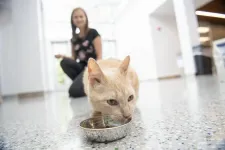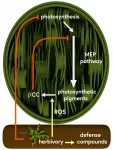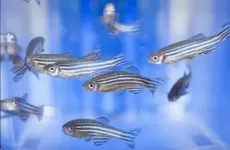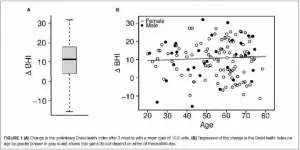(Press-News.org) URBANA, Ill. - If you haven't been the parent or caregiver of an infant in recent years, you'd be forgiven for missing the human milk oligosaccharide trend in infant formulas. These complex carbohydrate supplements mimic human breast milk and act like prebiotics, boosting beneficial microbes in babies' guts.
Milk oligosaccharides aren't just for humans, though; all mammals make them. And new University of Illinois research suggests milk oligosaccharides may be beneficial for cats and dogs when added to pet diets.
But before testing the compounds, scientists had to find them.
"When we first looked into this, there had only been one study on milk oligosaccharides in dogs, and none in domestic cats. The closest were really small studies on a single lion and a single clouded leopard," says Kelly Swanson, the Kraft Heinz Company Endowed Professor in Human Nutrition in the Department of Animal Sciences and the Division of Nutritional Sciences at Illinois.
"Our study was the first robust characterization of dog and cat milk oligosaccharides," he adds. "Our data not only provide a better understanding of how milk meets the nutritional needs of newborn kittens and puppies, but also how it helps promote gut immunity and establish a healthy gut microbial community early in life." That research appears in the journal PLoS ONE.
The foundational study identified three predominant oligosaccharide structures in canine milk: 3'sialyllactose, 6'-sialyllactose, and 2'fucosyllactose, the same compound showing up in many infant formulas today. Together, these three structures made up more than 90% of the total oligosaccharides in canine milk.
Feline milk was much more complex and balanced, with approximately 15 structures making up 90% of total oligosaccharides. Of these, difucosyllactose-N-hexaose b, 3'-sialyllactose, and lacto-N-neohexaose represented more than 10% each.
"Even though domestic dogs and cats both evolved as carnivores, they are metabolically distinct in many ways. Although pet cats still exist as true carnivores, pet dogs are omnivorous in nature," Swanson says. "These new milk oligosaccharide data highlight another interesting difference between the species, justifying further research to reveal their role in the nutritional and health status of newborn puppies and kittens."
Even before Swanson and his colleagues identified the oligosaccharides in cat and dog milk, the pet food industry was beginning to recognize the potential benefits of these compounds as supplements in pet foods. In 2019, Swiss biotech company Gnubiotics Sciences announced an animal milk oligosaccharide-like product known as GNU100, but it hadn't been tested in animals. Swanson's team took that on.
In two separate studies, both published in the Journal of Animal Science, Swanson and his colleagues determined the safety, palatability, and digestibility of GNU100 in dogs and cats.
First, in vitro laboratory tests with cellular colonies showed no toxic effects or tendencies to cause cell mutation. There was no reason to expect toxicity, but the result satisfies one of the basic FDA requirements for inclusion of any new ingredient in pet foods.
Next, the researchers mixed GNU100 at 1% with a fat source and coated commercial dry diets for cats or dogs. As a control, fat-coated diets without GNU100 were also offered. When animals got to choose between the control and 1% bowls, they went crazy for the GNU100.
"In the cats, it was a huge preference. They ate nearly 18 times more food with GNU100 than the control food. We had just been hoping they wouldn't reject it. You know, cats can be pretty finicky," Swanson says. "When we got the data back it was like, wow, they really love that stuff! And the dogs did, too."
Swanson explains GNU100 is composed of a complex mixture of oligosaccharides and peptides, small protein-containing compounds that may make the food more appetizing to cats and dogs.
Finally, the researchers included GNU100 in experimental diets at 0%, 0.5%, 1%, and 1.5% and fed them to healthy adult dogs and cats for six months. During that time, they measured stool quality, blood metabolites, and nutrient digestibility, and evaluated changes in gut metabolites and the gut microbial community.
Overall, cats and dogs did well with GNU100, with no adverse health effects. And the researchers saw shifts in the gut microbiome toward more beneficial species and their metabolite profiles.
Aside from the palatability test, changes associated with GNU100 were as expected, showing intriguing trends in gut microbiota and gut metabolites that Gnubiotics plans to explore in future studies. Swanson thinks they would have seen bigger benefits in a more targeted study focusing on newborn cats and dogs, geriatrics, or pets with compromised immune systems.
"Theoretically, these products should stabilize and feed good bacteria in the gut as well as limit the growth of potentially undesirable bacteria. So if an animal is undergoing treatment for something with antibiotics or is in a high stress situation, having that product in the diet might keep the gut from destabilizing," Swanson says. "Another target group for these products might be young animals as a way to maintain beneficial bacteria in the gut as they wean off their mothers. We'd need to do more testing to see if the product holds up in those target groups, but at least we know now that it is safe and well tolerated."
INFORMATION:
The three articles referenced here can be found online at:
https://journals.plos.org/plosone/article?id=10.1371/journal.pone.0243323 (Identifying milk oligosaccharides in dogs and cats)
https://academic.oup.com/jas/article-abstract/99/1/skaa399/6035126?redirectedFrom=fulltext (GNU100 tested in cats)
https://academic.oup.com/jas/article-abstract/99/1/skab014/6102879?redirectedFrom=fulltext (GNU100 tested in dogs)
The Department of Animal Sciences is in the College of Agricultural, Consumer and Environmental Sciences at the University of Illinois.
In a new study in PNAS, an international team of researchers including scientists from the Max Planck Institute for Chemical Ecology has shown that Arabidopsis thaliana plants produce beta-cyclocitral when attacked by herbivores and that this volatile signal inhibits the methylerythritol 4-phosphate (MEP) pathway. The MEP pathway is instrumental in plant growth processes, such as the production of pigments for photosynthesis. In addition to down-regulating the MEP pathway, beta-cyclocitral also increases plant defenses against herbivores. Since the MEP pathway is only found in plants and microorganisms, but not animals, knowledge of a signal molecule like beta-cyclocitral opens up new possibilities for the development ...
Brazilian researchers who study a native venomous fish have confirmed a route to drug development for the treatment of chronic inflammatory diseases such as multiple sclerosis and asthma.
The venomous toadfish Thalassophryne nattereri contains a peptide (TnP) with anti-inflammatory and anti-allergic potential. Confirmation of this potential has now come via the zebrafish Danio rerio, a popular aquarium species native to South Asia that shares 70% of its genome with humans and is widely used as a model for in vivo trials in drug development.
The researchers tested TnP in D. rerio to measure its toxicity. In a little over a year, their research showed that the peptide is safe. It did not cause cardiac dysfunction or neurological problems in the toxicity tests ...
Health care systems could save lives and minimize losses by optimizing resource allocation and implementing mitigation strategies, according to two new studies. Colorado State University researchers explored how our health care systems might perform under multiple disasters and multiple waves of COVID-19, and how we can keep them functioning when we need them most.
In the first study, published in Nature Communications, Civil and Environmental Engineering Ph.D. student Emad Hassan and Associate Professor Hussam Mahmoud investigated the compound effects of pandemics and natural disasters on health care systems. They combined wildfire ...
DALLAS (March 9, 2021) - Better brain health and performance for humankind is one step closer to reality with the successful trial of the groundbreaking BrainHealth Project. A cross-disciplinary team with the Center for BrainHealth® at The University of Texas at Dallas unveiled an easy-to-use online platform that delivers a novel, science-backed approach to measuring, improving and tracking one's own brain fitness.
A key innovation of the Project centers on the BrainHealth Index™ (BHI), which is based on a multidimensional definition of brain health and its upward potential. The BHI is a composite derived from a series of best-in-class assessments that explore ...
Farmers in the Midwest may be able to bypass the warming climate not by getting more water for their crops, but instead by adapting to climate change through soil management says a new study from Michigan State University.
"The Midwest supplies 30% of the world's corn and soybeans," said Bruno Basso, an ecosystems scientist and MSU Foundation Professor in the Department of Earth and Environmental Sciences within the College of Natural Science. "These crops are sensitive to temperature and water changes."
Previous studies have suggested that by 2050, the Midwest will need about 35% more water to sustain its current levels of corn and soybean yields. But research done by Basso and colleagues found that the data does not support this idea. The Midwest is in a unique location that ...
If past natural disasters have taught us anything about their effects on pregnant women and developing babies, it is to pay close attention, for the added stress will surely have an impact on them. Amanda Venta, associate professor of psychology at the University of Houston, is sounding that alarm as it relates to the COVID-19 pandemic in a newly released study published in Child Psychiatry & Human Development.
"There is strong evidence to suggest that the coronavirus pandemic will affect mothers and infants through immune pathways that, in previous research, have been shown to link stress and social isolation during the pre- and post-natal periods with deficits in maternal mental health and infant well-being and development across developmental stages," reports Venta.
Research ...
The relationship between the Hawaiian bobtail squid and the bioluminescent bacteria living in its light organ has been studied for decades as a model of symbiosis. Now researchers have used a powerful chemical analysis tool to identify a small molecule produced by the bacteria that appears to play an important role in their colonization of the light organ.
The study, published March 9 in the journal mBio, adds a new wrinkle to scientists' understanding of the chemical signaling involved in this iconic symbiotic relationship. "It's exciting that there are still new things to discover, even in such a well-studied system," said corresponding author Laura Sanchez, associate professor ...
A new systematic review of evidence recommends the use of behavioral self-management treatments for common urinary issues experienced by upwards of 70 percent of older men. Common symptoms include trouble urinating, increased frequency and incontinence. These symptoms can have a substantial negative impact on sleep, social functioning and quality of life. Several guidelines recommend self-management techniques like health education, advice on fluid intake, and bladder retraining; however, in practice, self-management is often excluded from the menu of treatment options that include medication and surgery.
Researchers at Bond University's Institute for Evidence-Based Healthcare found that self-management interventions reduced the severity of lower urinary tract symptoms. The ...
Wormholes play a key role in many science fiction films - often as a shortcut between two distant points in space. In physics, however, these tunnels in spacetime have remained purely hypothetical. An international team led by Dr. Jose Luis Blázquez-Salcedo of the University of Oldenburg has now presented a new theoretical model in the science journal Physical Review Letters that makes microscopic wormholes seem less far-fetched than in previous theories.
Wormholes, like black holes, appear in the equations of Albert Einstein's general theory ...
A mobile app designed to help women manage urinary incontinence was as effective as usual, in-person treatment of incontinence in primary care, according to new research from the Netherlands. The study included 262 women with frequent stress incontinence, overactive bladder or a mix of symptoms. Participants were randomly assigned to use a standalone mobile app called URinControl, which offered pelvic floor muscle and bladder training exercises. Those in a control group received standard care and were referred to their own primary care doctors who were broadly advised to follow the Dutch guidelines for primary care. After four months, ...





